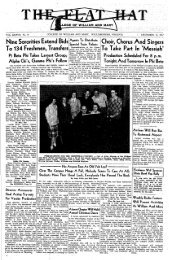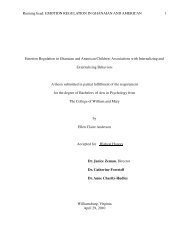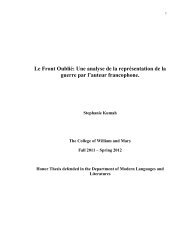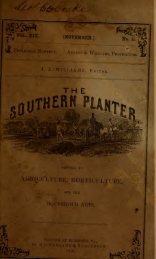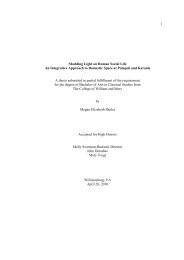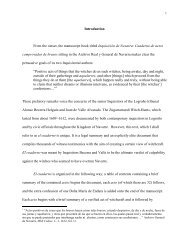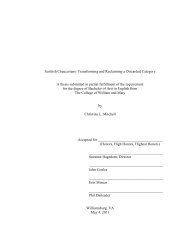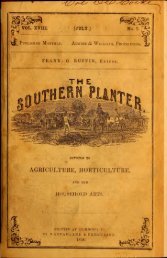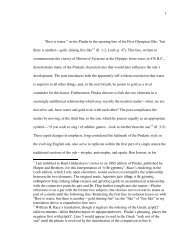Southern planter - The W&M Digital Archive
Southern planter - The W&M Digital Archive
Southern planter - The W&M Digital Archive
You also want an ePaper? Increase the reach of your titles
YUMPU automatically turns print PDFs into web optimized ePapers that Google loves.
1859.] THE SOUTHERN PLANTER 431<br />
tion. For instance, were we to take the<br />
juice of the sugar cane, (containing about<br />
20 per cent, of crystallizable sugar,) and<br />
concentrate it without subjecting it to the<br />
action of lime or some other defecating<br />
agent, fully half of the sugar would be rendered<br />
uncrystallizable, and there would be only<br />
a small yield of sugar but a large amount<br />
of molasses. For this reason in regarding<br />
the sugar-yielding capacity of any vegeta-<br />
ble, the two facts to be considered are, first,<br />
the quantity of cane sugar it contains, and<br />
secondly, the amount and character of the<br />
impurities associated with the sugar—for<br />
the latter, during the concentration of the<br />
juice, may give rise to the alteration already<br />
mentioned, or they may prevent the<br />
sugar from crystallizing without altering it.<br />
<strong>The</strong> juices of the sugar cane, beet- root,<br />
and maple, present about the best condi-<br />
tions of any of the vegetable juices for furnishing<br />
sugar, and according to the care<br />
and skill exercised in the working of them<br />
so is the yield of sugar.<br />
Without further preliminaries, I will proceed<br />
to state the results of the investiga-<br />
tion of the Sorgho mere, as far as possible<br />
to make it at the present time. Owing to<br />
the season being far advanced when the experiment<br />
was commenced, it was impossible<br />
to undertake anything more than a chemi-<br />
cal examination of the jaiice, as the frost<br />
had already affected most of the cane which<br />
was not cut. Here I would remark that it<br />
is of the utmost importance to examine<br />
plants perfectly fresh and unaltered, if we<br />
expect correct results in relation to the<br />
crystallizable sugar they will produce ; and<br />
it is a well known fact that even the broken<br />
and bruised canes of a field will deteriorate<br />
the juices, if passed through the mill with<br />
the perfect canes. Even on the surface<br />
which is cut, an alteration commences, at<br />
once the sugar is changed, and this alteration<br />
gradually creeps from the cut extrem-<br />
ity into all joints of the stalk. I have verified<br />
this fact in relation to the sorgho. By<br />
examining different joints, after it had been<br />
cut two or three weeks, the results were as<br />
follows, the joints being numbered from the<br />
extremity next to the root<br />
Juice from Crystallizable Uncrystallizable<br />
joints. sugar. sugar.<br />
1st jt. contained 6 per cent. 7 percent.<br />
3d jt. contained 8 per cent. 4£ pr. cent.<br />
5th jt. contained 9£ pr. cent. 4 pr. cent.<br />
1 1* nee it is evident that no time is to be<br />
lost, after cutting it, in expressing the<br />
juice.<br />
Not being able to supply myself with the<br />
fresh cane as Deeded for examination, the<br />
structure of the plant, with reference to its<br />
sugar-bearing cells, was not investigated.<br />
My inquiries, therefore, were directed to<br />
the more important study of the composi-<br />
tion of the juice.<br />
Some of the sorgho, perfectly matured<br />
and recently cut, was compressed, and the<br />
juice submitted immediately to analysis.<br />
<strong>The</strong> process adopted for ascertaining the<br />
quality and character of sugar is the only<br />
one that can be relied on for anything like<br />
accurate results. It is known as the<br />
process by polarized light, in which the<br />
juice to be examined is first made in a few<br />
moments as transparent and colourless as<br />
water, and that without the agency of heat.<br />
<strong>The</strong> juice as compressed is of a light green<br />
colour, opaque, and largely mixed with cell-<br />
ulous tissue from the plant. It is readily<br />
clarified by acetate of lead, and when thus<br />
submitted to examination by Solid's polarizing<br />
saccharometer, three specimens gave<br />
the following results<br />
No. of Crystallizable N Dn-Crystallizable<br />
specimens. sugar. sugar.<br />
1st. 10 per cent. l£ per cent.<br />
2d. 9^ per cent. 2 per cent.<br />
3d. 10 per cent. 2 per cent.<br />
<strong>The</strong> result settles the question that the<br />
gfreat bulk of the sugar contained in the<br />
sorgho is crystallizable or cane sugar pro-<br />
per.<br />
<strong>The</strong> difference of opinion which has existed<br />
on this subject, doubtless arose from<br />
the fact that different degrees of care had<br />
been taken in the concentration of the<br />
juice, or that a more or less perfect process<br />
of defecation was resorted to, sometimes<br />
rendering the juice altogether crystallizable,<br />
while at others it furnished a reasonable<br />
quantity of sugar.<br />
<strong>The</strong> results obtained in the analysis of<br />
liquids containing sugar by polarized light<br />
are especially valuable, as the impurities<br />
which may be associated with the sugar in<br />
no way affect the accuracy of the analysis,<br />
the only requisite being to render it perfectly<br />
transparent. Besides the sugar and<br />
water contained in the sorgho, the following<br />
constituents are found : Cellulose, woody<br />
fibre, pectine, pectic acid, albuminous mat-



